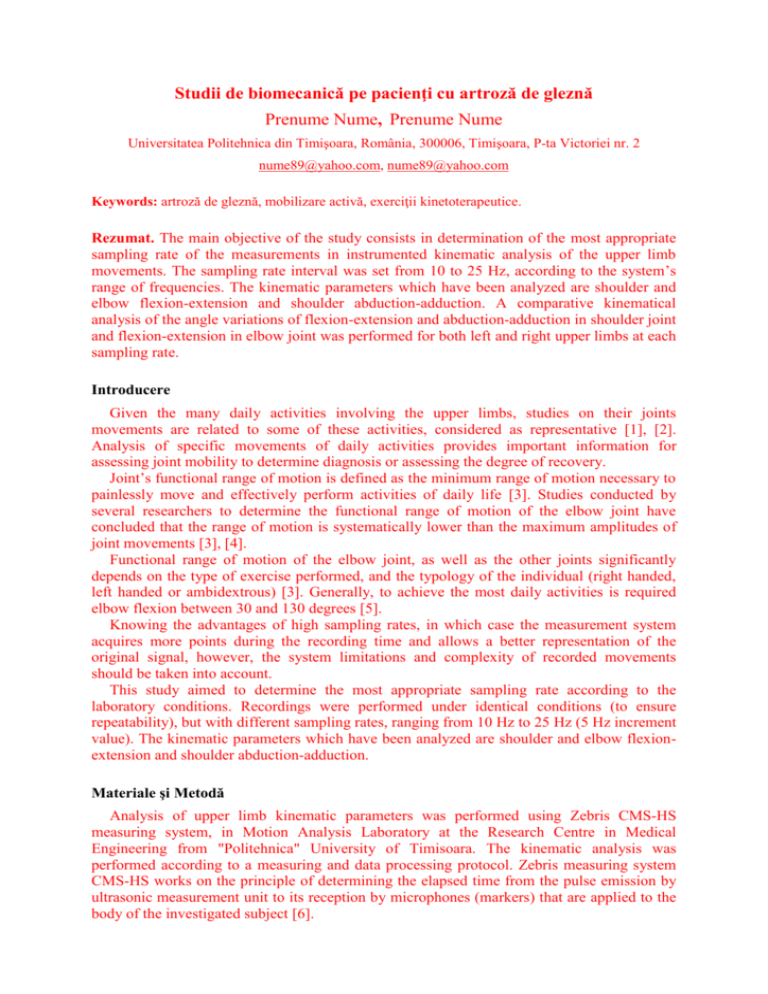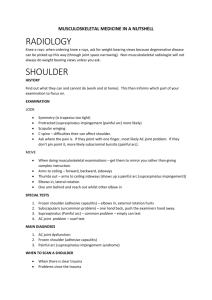Your Paper`s Title Starts Here:
advertisement

Studii de biomecanică pe pacienţi cu artroză de gleznă Prenume Nume, Prenume Nume Universitatea Politehnica din Timişoara, România, 300006, Timişoara, P-ta Victoriei nr. 2 nume89@yahoo.com, nume89@yahoo.com Keywords: artroză de gleznă, mobilizare activă, exerciţii kinetoterapeutice. Rezumat. The main objective of the study consists in determination of the most appropriate sampling rate of the measurements in instrumented kinematic analysis of the upper limb movements. The sampling rate interval was set from 10 to 25 Hz, according to the system’s range of frequencies. The kinematic parameters which have been analyzed are shoulder and elbow flexion-extension and shoulder abduction-adduction. A comparative kinematical analysis of the angle variations of flexion-extension and abduction-adduction in shoulder joint and flexion-extension in elbow joint was performed for both left and right upper limbs at each sampling rate. Introducere Given the many daily activities involving the upper limbs, studies on their joints movements are related to some of these activities, considered as representative [1], [2]. Analysis of specific movements of daily activities provides important information for assessing joint mobility to determine diagnosis or assessing the degree of recovery. Joint’s functional range of motion is defined as the minimum range of motion necessary to painlessly move and effectively perform activities of daily life [3]. Studies conducted by several researchers to determine the functional range of motion of the elbow joint have concluded that the range of motion is systematically lower than the maximum amplitudes of joint movements [3], [4]. Functional range of motion of the elbow joint, as well as the other joints significantly depends on the type of exercise performed, and the typology of the individual (right handed, left handed or ambidextrous) [3]. Generally, to achieve the most daily activities is required elbow flexion between 30 and 130 degrees [5]. Knowing the advantages of high sampling rates, in which case the measurement system acquires more points during the recording time and allows a better representation of the original signal, however, the system limitations and complexity of recorded movements should be taken into account. This study aimed to determine the most appropriate sampling rate according to the laboratory conditions. Recordings were performed under identical conditions (to ensure repeatability), but with different sampling rates, ranging from 10 Hz to 25 Hz (5 Hz increment value). The kinematic parameters which have been analyzed are shoulder and elbow flexionextension and shoulder abduction-adduction. Materiale şi Metodă Analysis of upper limb kinematic parameters was performed using Zebris CMS-HS measuring system, in Motion Analysis Laboratory at the Research Centre in Medical Engineering from "Politehnica" University of Timisoara. The kinematic analysis was performed according to a measuring and data processing protocol. Zebris measuring system CMS-HS works on the principle of determining the elapsed time from the pulse emission by ultrasonic measurement unit to its reception by microphones (markers) that are applied to the body of the investigated subject [6]. One healthy volunteer (female, 28 years old) has involved in the study based on her informed consent. The subject stated that there is no evidence of any pathology of the upper limb or spine. The subject was positioned at a distance of about 0.5 m from each of the two ultrasound emitters in orthostatic position (Fig. 1). Two ultrasound marker sets (one set on the upper limb and the second one on the lower limb) were attached on each side of the subject body by means of double-sided adhesive patches, according to Zebris Operating Instructions [6]. The exercise movements simulate a common activity of daily life - eating. During the recordings, the subject maintains its body steady while moving her upper limbs, one for each set of records. The movement cycle of was defined as follows: upper limb starts from the position of slight flexion (approximately 20 °) of the elbow with the palm facing lower limb; upper limb rises to the nose, until the hand reaches the tip of the nose with the tip of the middle finger; upper limb returns to its start position. In order to adapt her movements to the measurement conditions and execute a repeatable movement (set free) a training session of three minutes was firstly performed. After this session ten anatomical landmarks have been marked on each subject side using the system pointer (Fig. 2). Fig. 1. Subject positioning Fig. 2. Anatomical landmarks From the beginning it was observed that 5 Hz sampling rate induces a very long delay in signal acquisition. this sampling rate, the events in the human arm motion are manly lost. So, no measurements were recorded at this sampling rate. It was also observed that staring with 28 Hz sampling rate, the measuring unit’s memory buffer is not able to send all acquired data to the computer. This leads to large range of NaN values in the subject’s recordings. 25 Hz sampling rate it’s just on the edge of good recording. The measurements have been individually recorded for each sampling rate (10 Hz ÷ 25 Hz) and limbs. One exercise corresponds to a certain sampling rate and consists in three trials of six movement cycles. The data acquired by the measuring system are the spatial coordinates of the anatomical landmarks. WinGait software generates the geometrical model and allows determining of the joint angles variation during the selected cycles. The raw data have been exported from the WinGait software for further processing. Rezultate The joint angles have been averaged per each trial and exercise. The time period of the movement cycle was of 1.8 sec for all the recorded measurements. The variability of the joint angles was evaluated by computing the standard deviations. The movement symmetry between left and right upper limbs for each considered sampling rate was evaluated based on an unpaired t-test and Pearson correlation coefficient of the averaged series. There were evaluated the following characteristics: maximum values of the joint angles, curve smoothness, variability of the joint angles, and symmetry between left and right upper limbs. Fig. 3 to Fig. 5 present the averaged angles variations in shoulder and elbow joints of both left and right upper limb for the studied sampling rates during one movement cycle. The shape of flexion-extension movement graph is a convex parabola (Fig. 3). Movement starts at about 0 ° from neutral position and reaches the maximum value when the finger touches the tip of the nose (approx. 0.8 sec), regardless of sample rate recording. It was noted that, in case of left upper limb differences appear only for the maximum angle of flexionextension (values recorded for 25 Hz), while for the right upper limb, the differences are smaller in terms of movement amplitudes, but return to neutral position is different. There were observed significant differences between the maximum values of abductionadduction angle in shoulders, meaning the angle of the right shoulder joint (Fig. 4) is nearly double the value of the left side. It also has been noted that there are differences in terms of the moments corresponding to maximum values. Graph of flexion-extension movement in elbow joint (Fig. 5) has the shape of a concave parabola. Recorded values range from about 20 ° which is the start position of the exercise with slightly flexed elbow joint and increase to the maximum value when the tip of the middle finger of the hand reaches the tip of the nose. From Table 1 it can be seen that the subject executes larger movements of flexionextension and abduction-adduction in right shoulder joint and larger movements of flexionextension in the left elbow joint. left right Fig. 3. Flexion/Extension movement in shoulder joint right left Fig. 5. Flexion/Extension movement in elbow joint The movement symmetry between the left and right side was analyzed using statistical tests such as t-test and Pearson correlation coefficient (Table 2). The reference value of P was chosen equal to 0.05 (95% confidence interval). There were found significant differences of abduction-adduction movements (P-value <0.05) and no significant statistical difference for flexion / extension in the shoulder and elbow joint (P-value >0.05). Pearson's correlation coefficient values close in absolute value to 1 means a strong linear relationship between two compared variables. It can be seen that there is a very good combination for all sampling rates for movements of flexion-extension, but an acceptable degree of association of abductionadduction movements. Joint Movement Flexion Shoulder Abduction Elbow Flexion Maximum value Average STDV Maximum value Average STDV Maximum value Average STDV Upper limb Left Right Left Right Left Right Left Right Left Right Left Right 10 Hz -42,600 -48,238 2,736 3,707 9,548 14,575 1,013 1,413 128,225 125,113 4,594 6,023 Sampling rate 15 Hz 20 Hz -49,975 -46,950 -50,813 -49,763 2,163 1,840 3,210 3,954 9,580 9,588 15,975 16,600 0,956 1,096 1,264 1,707 127,613 128,713 123,275 125,663 4,355 4,928 4,226 7,294 25 Hz -49,975 -51,338 3,231 3,535 9,753 17,563 1,441 1,397 128,838 125,700 6,032 5,356 Table 1 Maximum values of angles in shoulder and elbow joints and average standard deviations Concluzii Both graphs and numerical results underline the specific movement pattern of the investigated subject. The main difference consists in abduction-adduction movement of the shoulder joint. As expected, it is observed that when the sampling rate increases the representations of the movement cycles are more accurate. It is observed that the maximum angular amplitudes were recorded at sampling rate of 25 Hz. We can conclude that the best results according to the measuring configuration, physical exercise, and considered criteria have been accomplished in case of 25Hz sampling rate. If the same hardware configuration is used to analyze more complex movements, it is recommended to use a sampling rate of 20Hz. Further research will study other activities of daily life using larger and homogeneous lots of studies, consisting in healthy subjects and patients with different pathologies, including arthroplasty. Bibliografie [1] [2] [3] [4] [5] [6] I.A.Murray, G.R.Johnson, A study of external forces and moments at the shoulder and elbow while performing every day tasks, Clin Biomech 19 (2004) 586-594. D.J. Magemans, E.K.J. Chadwick, H.E.J. Veeger, F.C.T. Van der Helm, Requirements for upper extremity motions during activities of daily living, Clin Biomech 20 (2005) 591-599. S. Namdari, G. Yagnik, D.D. Ebaugh, S. Nagda, M.L. Ramsey, G.R. Williams Jr., S. Mehta, Defining functional shoulder range of motion for activities of daily living, J Shoulder Elbow Surg 21 (2012) 1177-1183. M.Sardelli, R.Z. Tashjian, B.A MacWilliams, Functional elbow range of motion for contemporary tasks, J Bone Joint Surg Am, 93 (2011) 471-747. B.F. Morrey, J. Sanchez-Sotelo, The Elbow and Its Disorders, fourth ed, Saunders Elsevier, 2009. Zebris Medical GmbH, Measuring System for 3D-Motion Analysis, CMS-HS/CMSHSL, Technical data and operating instructions (2006).







